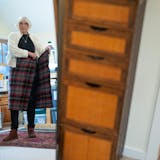After a two-year pandemic-related hiatus, the historic Purcell-Cutts House near Lake of the Isles in Minneapolis has reopened to the public.
The Prairie School jewel, designed by architects William Gray Purcell and George Grant Elmslie for Purcell and his wife, Edna, was built in 1913. The home was bequeathed to the Minneapolis Institute of Art (Mia) in 1985 by Anson Cutts Jr., son of the house's longtime owners, Edna and Anson Cutts. After a careful restoration, overseen by Minneapolis-based MacDonald & Mack Architects, the house was opened to the public in 1990.
The pandemic pause allowed the museum to take on preservation projects, including the task of refinishing woodwork throughout the house. The time-out also gave curators the opportunity to rethink the tour dialogue. While the house's architecture remains at the forefront, the conversation now includes a look into the way health concerns influenced the house's design, and the roles played by local women pioneers in architecture.
Jennifer Komar Olivarez, Mia's Head of Exhibition Planning and Strategy and Interim Curator of the Purcell-Cutts House, offered a recent tour, where she revealed that the house. ...
... Doesn't feel old, despite its 109-year age: "Purcell wanted a house for a modern family," said Olivarez. "He was thinking of breaking out of Victorian conventions and living life in a more informal way. That's one of the things that really resonates with visitors when they come here. They feel like they could live here, even though it's obviously a museum. The scale, the flexibility, the open plan, the connection between the indoors and the outdoors, it's all part and parcel of what he talked about."
... Was built for $14,000, which is about $385,000 in today's dollars: "That was a lot of money, considering that the cost for a middle-class house was around $2,500," said Olivarez. "It ended up being a pretty expensive endeavor. With the level of detail, it all adds up. Part of the [Prairie School] philosophy was 'good design, for all,' but Purcell had a hard time reconciling that with the lack of customization that he thought was so important.
"To design a house that could be plopped anywhere was sort of antithetical to the way he approached design, because for him it was about the siting, and the light, and the client. He wanted to design types that could be made available on more of a mass scale to middle-class Americans, but he never achieved that goal."
... Was home to the well-to-do Purcell family for just a few years: "Purcell sold the house in 1919, and then the Cutts family had it for 66 years," said Olivarez. "They didn't really make any permanent changes. The Cutts really understood what the house meant to Purcell and how important it was as a work of architecture."


